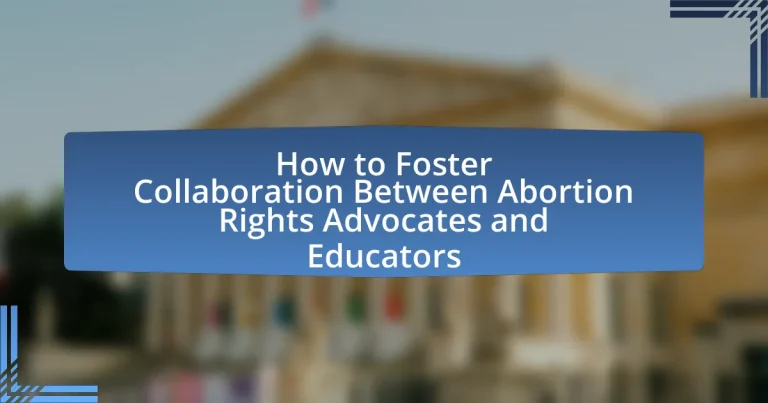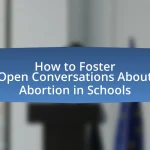The article focuses on fostering collaboration between abortion rights advocates and educators to enhance comprehensive sexual education and informed decision-making regarding reproductive health. It outlines the importance of integrating accurate information about abortion rights into educational curricula, which can lead to better health outcomes and reduced stigma. Key strategies for effective collaboration include establishing open communication, setting shared goals, and creating joint initiatives, while addressing challenges such as differing ideologies and misconceptions. The article emphasizes the positive impact of this partnership on student engagement, awareness, and advocacy skills, ultimately contributing to a more informed and empowered student body.
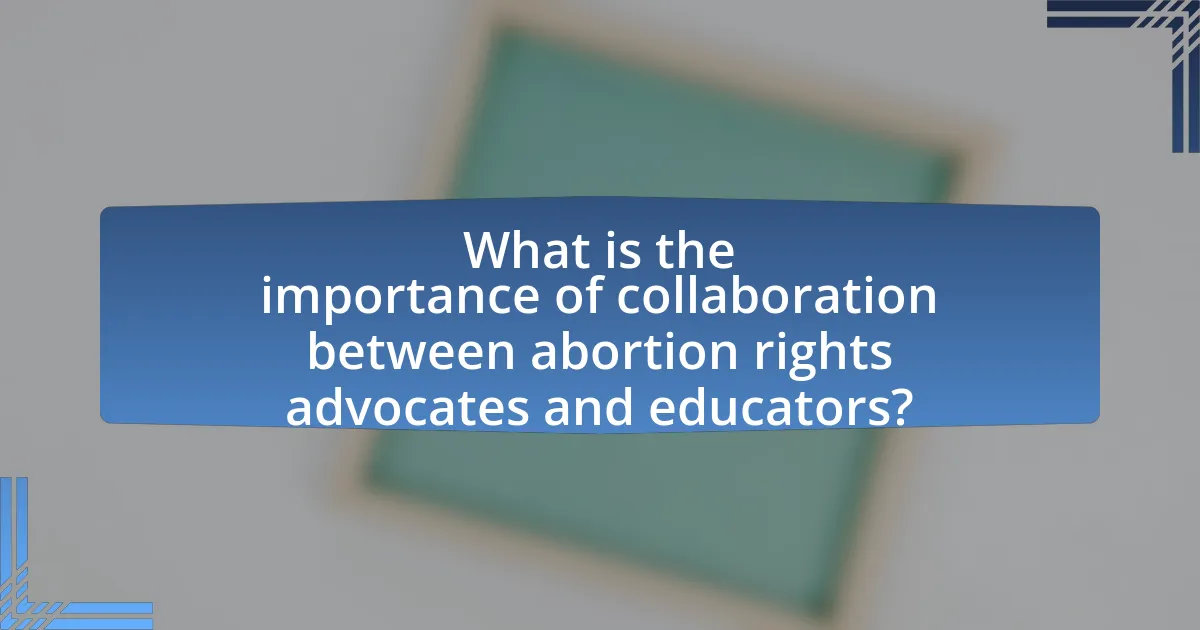
What is the importance of collaboration between abortion rights advocates and educators?
Collaboration between abortion rights advocates and educators is crucial for promoting comprehensive sexual education and informed decision-making regarding reproductive health. This partnership enables educators to incorporate accurate information about abortion rights into curricula, fostering a more informed student body. Research indicates that comprehensive sexual education can lead to reduced rates of unintended pregnancies and sexually transmitted infections, highlighting the effectiveness of informed education. Furthermore, advocates can provide resources and support to educators, ensuring that they are equipped to address sensitive topics with accuracy and empathy. This synergy ultimately empowers students to make informed choices about their reproductive health.
How can collaboration enhance educational outcomes related to abortion rights?
Collaboration can enhance educational outcomes related to abortion rights by integrating diverse perspectives and expertise, leading to more comprehensive and accurate educational materials. When abortion rights advocates work alongside educators, they can provide up-to-date information on legal, medical, and social aspects of abortion, ensuring that students receive a well-rounded understanding of the topic. For instance, studies show that comprehensive sex education, which includes discussions on abortion, leads to better decision-making among adolescents regarding reproductive health. By pooling resources and knowledge, collaborative efforts can create curricula that not only inform but also empower students to engage in informed discussions about their rights and choices.
What specific educational goals can be achieved through this collaboration?
This collaboration can achieve specific educational goals such as increasing awareness of reproductive rights, enhancing critical thinking skills regarding social justice issues, and fostering a comprehensive understanding of health education. By integrating the expertise of abortion rights advocates with educators, students can engage in informed discussions, access accurate information, and develop advocacy skills. Research indicates that educational programs that include diverse perspectives on reproductive health lead to improved student engagement and knowledge retention, as evidenced by studies conducted by the Guttmacher Institute, which highlight the importance of comprehensive sex education in promoting informed decision-making among youth.
How does collaboration impact students’ understanding of reproductive rights?
Collaboration enhances students’ understanding of reproductive rights by facilitating diverse perspectives and comprehensive discussions. When educators partner with abortion rights advocates, they create an environment where students can engage with accurate information, challenge misconceptions, and explore the complexities of reproductive health. Research indicates that collaborative learning experiences lead to deeper comprehension and retention of information, as students are more likely to critically analyze topics when exposed to varied viewpoints and expert insights. This approach not only informs students about their rights but also empowers them to advocate for themselves and others, fostering a more informed and active citizenry.
Why is it essential for abortion rights advocates to engage with educators?
Engaging with educators is essential for abortion rights advocates because educators play a crucial role in shaping the knowledge and attitudes of young people regarding reproductive health. By collaborating with educators, advocates can ensure that accurate information about abortion rights and reproductive health is integrated into curricula, thereby fostering informed discussions among students. Research indicates that comprehensive sex education, which includes information about abortion, leads to better health outcomes and reduces stigma associated with reproductive choices. For instance, a study published in the Journal of Adolescent Health found that students who received comprehensive sex education were more likely to make informed decisions about their reproductive health. Thus, the partnership between abortion rights advocates and educators is vital for promoting awareness and understanding of reproductive rights among future generations.
What unique perspectives do educators bring to the abortion rights conversation?
Educators bring critical perspectives to the abortion rights conversation by emphasizing the importance of comprehensive sex education and informed decision-making. Their expertise in pedagogy allows them to advocate for curricula that include discussions on reproductive health, which can lead to better understanding and awareness among students. Research indicates that states with comprehensive sex education have lower rates of unintended pregnancies and abortions, highlighting the effectiveness of informed education in shaping attitudes and behaviors. Furthermore, educators can address the socio-emotional aspects of reproductive choices, fostering an environment where students feel safe to discuss and explore these topics openly.
How can educators help in dispelling myths about abortion rights?
Educators can help dispel myths about abortion rights by providing accurate, evidence-based information in their curricula. By integrating comprehensive sex education and discussions about reproductive rights into their teaching, educators can clarify misconceptions surrounding abortion. For instance, research from the Guttmacher Institute indicates that comprehensive sex education reduces misinformation and promotes understanding of reproductive health issues. Furthermore, educators can facilitate open dialogues that encourage critical thinking and address common myths, such as the misconception that abortion is unsafe. According to the World Health Organization, legal abortions performed by trained professionals are safe and effective, which counters prevalent myths. By fostering an informed environment, educators play a crucial role in shaping students’ understanding of abortion rights.
What challenges exist in fostering collaboration between these groups?
Fostering collaboration between abortion rights advocates and educators faces several challenges, primarily stemming from differing ideologies and priorities. Abortion rights advocates often prioritize reproductive autonomy and access to services, while educators may focus on providing comprehensive sexual education and ensuring student welfare. This ideological divide can lead to misunderstandings and conflicts regarding the goals of collaboration. Additionally, legal and institutional barriers, such as restrictions on discussing abortion in educational settings, further complicate efforts to work together. Research indicates that these barriers can hinder effective communication and limit the scope of collaborative initiatives, making it difficult to align objectives and strategies.
What are the common misconceptions that hinder collaboration?
Common misconceptions that hinder collaboration include the belief that differing viewpoints are irreconcilable and that collaboration requires complete agreement. These misconceptions create barriers by fostering an environment of distrust and discouraging open dialogue. Research indicates that when individuals perceive their perspectives as fundamentally opposed, they are less likely to engage in constructive discussions, which is essential for effective collaboration. Additionally, the assumption that collaboration is only successful when all parties share identical goals can prevent diverse stakeholders, such as abortion rights advocates and educators, from finding common ground and working together towards shared objectives.
How can differing ideologies create barriers to effective partnership?
Differing ideologies can create barriers to effective partnership by fostering mistrust and miscommunication between parties. When abortion rights advocates and educators hold fundamentally opposing beliefs about reproductive rights, these ideological differences can lead to conflicts in goals and methods. For instance, advocates may prioritize access to abortion services, while educators might focus on promoting abstinence or parental consent, resulting in a lack of alignment in their collaborative efforts. This misalignment can hinder open dialogue and compromise, as each group may perceive the other’s stance as a threat to their core values. Research indicates that ideological divides often lead to polarized discussions, which can stifle productive collaboration and limit the potential for shared initiatives aimed at improving educational outcomes related to reproductive health.
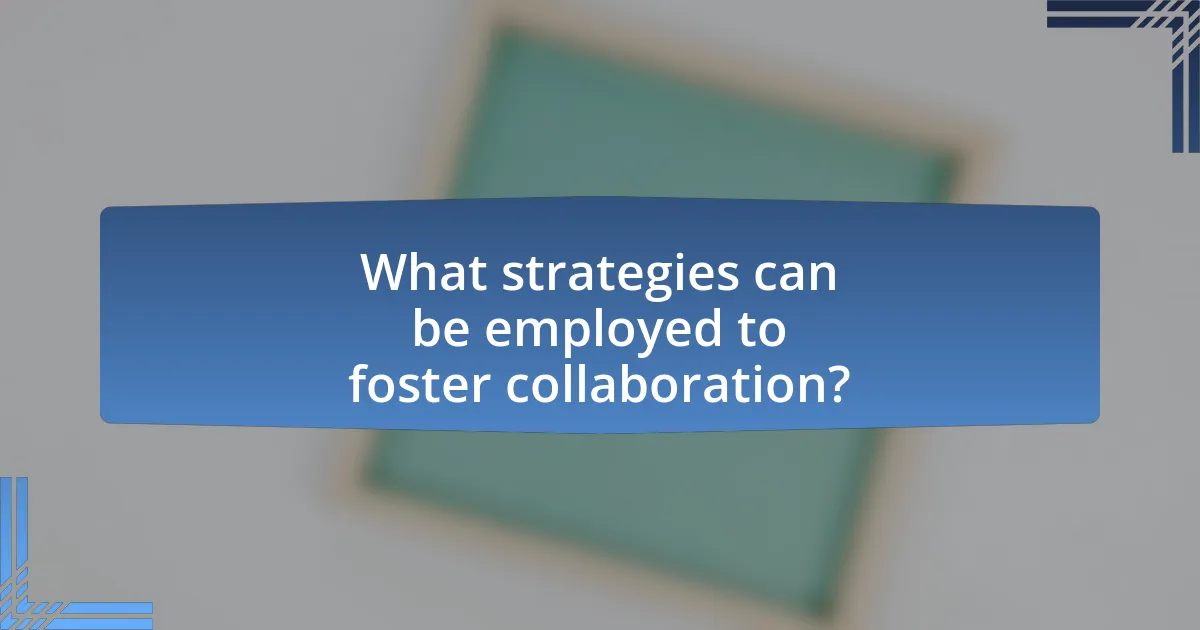
What strategies can be employed to foster collaboration?
To foster collaboration between abortion rights advocates and educators, establishing open communication channels is essential. This can be achieved through regular meetings, workshops, and joint events that encourage dialogue and understanding of each group’s perspectives. Research indicates that collaborative efforts, such as the partnership between the National Abortion Federation and educational institutions, have led to more informed discussions and policy development. Additionally, creating shared goals and objectives can align both parties’ efforts, enhancing their ability to work together effectively.
How can joint initiatives be developed between abortion rights advocates and educators?
Joint initiatives can be developed between abortion rights advocates and educators through collaborative workshops and curriculum integration. By organizing workshops, both parties can share knowledge, resources, and strategies to promote comprehensive sexual education that includes information on reproductive rights. For instance, the Guttmacher Institute emphasizes the importance of accurate sexual health education in reducing unintended pregnancies, which aligns with the goals of abortion rights advocates. Additionally, integrating abortion rights topics into existing educational frameworks can foster understanding and support among students, creating a more informed community.
What types of programs can be created to facilitate this collaboration?
Programs that can be created to facilitate collaboration between abortion rights advocates and educators include joint workshops, educational seminars, and community outreach initiatives. Joint workshops can provide a platform for sharing knowledge and strategies, while educational seminars can focus on the legal, ethical, and health aspects of abortion rights, fostering a deeper understanding among educators. Community outreach initiatives can engage parents and students, promoting dialogue and awareness about reproductive rights. These programs are effective as they encourage active participation and create a shared understanding of the issues at hand, ultimately leading to a more informed and supportive community.
How can workshops and training sessions be structured for maximum impact?
Workshops and training sessions can be structured for maximum impact by incorporating interactive elements, clear objectives, and diverse learning methods. Interactive elements, such as group discussions and hands-on activities, engage participants and enhance retention of information. Setting clear objectives ensures that all activities align with desired outcomes, making the sessions more focused and effective. Additionally, utilizing diverse learning methods, including visual aids, case studies, and role-playing, caters to different learning styles and keeps participants engaged. Research indicates that active learning strategies can improve knowledge retention by up to 75%, demonstrating the effectiveness of this structured approach.
What role does communication play in fostering collaboration?
Communication is essential in fostering collaboration as it facilitates the exchange of ideas, clarifies goals, and builds trust among participants. Effective communication ensures that all parties involved understand each other’s perspectives, which is crucial in sensitive topics like abortion rights. Research indicates that organizations with strong communication practices experience 25% higher productivity and improved team dynamics, highlighting the importance of clear dialogue in collaborative efforts. By establishing open lines of communication, abortion rights advocates and educators can work together more effectively, aligning their objectives and strategies to create a unified approach.
How can effective communication strategies be implemented?
Effective communication strategies can be implemented by establishing clear objectives, utilizing active listening, and fostering an inclusive environment. Clear objectives ensure that all parties understand the goals of the communication, which is essential for collaboration between abortion rights advocates and educators. Active listening promotes understanding and respect, allowing participants to engage meaningfully with each other’s perspectives. Fostering an inclusive environment encourages diverse viewpoints, which can enhance the dialogue and lead to more effective outcomes. Research indicates that organizations with strong communication practices are 25% more likely to achieve their goals, highlighting the importance of these strategies in collaborative efforts.
What tools can be used to enhance dialogue between advocates and educators?
Tools that can enhance dialogue between advocates and educators include structured communication platforms, collaborative workshops, and digital forums. Structured communication platforms, such as shared online documents and project management tools, facilitate real-time collaboration and information sharing. Collaborative workshops provide a space for face-to-face interaction, allowing both parties to discuss concerns and strategies in a focused environment. Digital forums, like social media groups or dedicated websites, enable ongoing discussions and resource sharing, fostering a continuous exchange of ideas. These tools collectively promote understanding and cooperation, essential for effective collaboration on sensitive topics like abortion rights.
How can community involvement support collaboration efforts?
Community involvement enhances collaboration efforts by fostering trust, shared goals, and resource sharing among stakeholders. When community members actively participate, they bring diverse perspectives and local knowledge, which can lead to more effective strategies and solutions. For instance, a study by the National Civic League found that communities with high levels of engagement are more likely to achieve successful outcomes in collaborative initiatives, as they leverage local networks and build stronger relationships. This collective effort not only strengthens the collaboration but also ensures that the initiatives are more relevant and responsive to the community’s needs.
What are the benefits of involving parents and community members?
Involving parents and community members enhances educational outcomes and fosters a supportive environment for students. Research indicates that when parents engage in school activities, students demonstrate improved academic performance, higher attendance rates, and better social skills. For instance, a study by the Harvard Family Research Project found that students whose parents are involved in their education are more likely to earn higher grades and test scores. Additionally, community involvement can lead to increased resources and support for schools, creating a collaborative atmosphere that benefits both students and educators.
How can local organizations contribute to collaborative efforts?
Local organizations can contribute to collaborative efforts by facilitating communication and resource sharing among stakeholders. They can organize joint events, workshops, and forums that bring together abortion rights advocates and educators to discuss common goals and strategies. For instance, local organizations can leverage their community connections to mobilize support and create awareness campaigns that educate the public on reproductive rights. Research indicates that collaboration enhances the effectiveness of advocacy efforts, as seen in the 2019 study by the Guttmacher Institute, which found that coordinated actions between different groups lead to more significant policy changes.
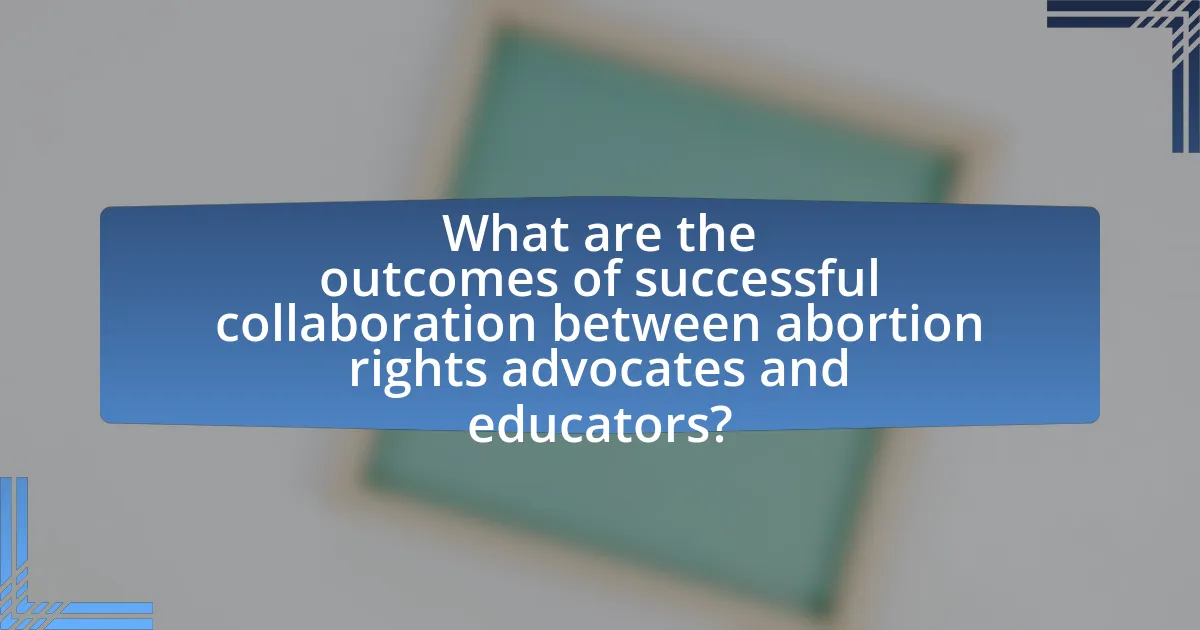
What are the outcomes of successful collaboration between abortion rights advocates and educators?
Successful collaboration between abortion rights advocates and educators leads to improved reproductive health education and increased awareness of abortion rights. This partnership enhances curriculum development, ensuring that educational materials are accurate, comprehensive, and inclusive of diverse perspectives on reproductive health. For instance, studies have shown that schools implementing comprehensive sex education programs, which include discussions on abortion, report higher levels of understanding among students regarding their reproductive rights and options. Additionally, collaboration fosters a supportive environment where students feel empowered to seek information and resources related to reproductive health, ultimately contributing to informed decision-making.
How does collaboration influence policy changes in education regarding abortion rights?
Collaboration significantly influences policy changes in education regarding abortion rights by uniting diverse stakeholders to advocate for comprehensive reproductive health education. When educators partner with abortion rights advocates, they can share resources, expertise, and data that highlight the importance of informed decision-making among students. For instance, studies show that states with collaborative efforts between educational institutions and reproductive health organizations have implemented more inclusive curricula that address abortion rights, leading to increased awareness and support among students. This collaborative approach not only enhances educational content but also fosters a supportive environment for policy advocacy, ultimately resulting in more progressive educational policies that reflect the needs and rights of students.
What specific policies have been influenced by such collaborations?
Collaborations between abortion rights advocates and educators have influenced specific policies such as comprehensive sex education mandates and reproductive health curriculum standards. For instance, states like California have enacted laws requiring public schools to include comprehensive sexual health education that addresses reproductive rights, reflecting the input from both advocacy groups and educational stakeholders. Additionally, policies promoting access to contraceptive services in school health programs have emerged from these collaborations, ensuring that students receive accurate information about their reproductive health options.
How can successful outcomes be measured and evaluated?
Successful outcomes can be measured and evaluated through specific metrics such as stakeholder feedback, quantitative data analysis, and achievement of predefined goals. Stakeholder feedback can be gathered through surveys and interviews, providing qualitative insights into the effectiveness of collaboration between abortion rights advocates and educators. Quantitative data analysis involves tracking participation rates, educational outcomes, and policy changes resulting from collaborative efforts. Additionally, the achievement of predefined goals, such as increased awareness or improved educational resources, serves as a benchmark for evaluating success. These methods ensure a comprehensive assessment of the collaboration’s impact and effectiveness.
What impact does collaboration have on student engagement and awareness?
Collaboration significantly enhances student engagement and awareness by fostering a sense of community and shared purpose among learners. When students work together on projects or discussions, they are more likely to participate actively, leading to increased motivation and interest in the subject matter. Research indicates that collaborative learning environments can improve critical thinking skills and retention of information, as students are encouraged to articulate their thoughts and consider diverse perspectives. For instance, a study published in the Journal of Educational Psychology found that students who engaged in collaborative learning reported higher levels of engagement and satisfaction compared to those who learned individually. This evidence underscores the positive impact of collaboration on both engagement and awareness in educational settings.
How can increased awareness lead to informed decision-making among students?
Increased awareness enables students to make informed decisions by providing them with essential knowledge about issues, options, and consequences. When students are aware of various perspectives and factual information regarding topics such as reproductive rights, they can critically evaluate their choices. Research indicates that informed students are more likely to engage in discussions and seek out resources, leading to better understanding and responsible decision-making. For instance, a study published in the Journal of Adolescent Health found that comprehensive education on reproductive health significantly improved students’ ability to make informed choices regarding their sexual health. This demonstrates that heightened awareness directly correlates with enhanced decision-making capabilities among students.
What feedback mechanisms can be established to assess student understanding?
Feedback mechanisms that can be established to assess student understanding include formative assessments, peer reviews, and reflective journals. Formative assessments, such as quizzes and polls, provide immediate insights into student comprehension and can guide instructional adjustments. Peer reviews encourage collaborative learning and allow students to engage critically with each other’s work, enhancing their understanding. Reflective journals enable students to articulate their learning processes and self-assess their understanding, fostering deeper cognitive engagement. These mechanisms are supported by educational research indicating that regular feedback significantly improves learning outcomes and retention of information.
What best practices can be adopted for effective collaboration?
Effective collaboration can be achieved by establishing clear communication channels, setting shared goals, and fostering mutual respect among participants. Clear communication ensures that all parties understand their roles and responsibilities, which is essential for coordinated efforts. Setting shared goals aligns the objectives of abortion rights advocates and educators, creating a unified direction for their collaboration. Mutual respect builds trust, allowing for open dialogue and the exchange of diverse perspectives, which is crucial in sensitive discussions surrounding abortion rights. Research indicates that collaborative efforts are more successful when these practices are implemented, as they enhance teamwork and lead to more effective outcomes.
How can ongoing training and support be provided to both advocates and educators?
Ongoing training and support for both advocates and educators can be provided through structured professional development programs that focus on current issues, strategies, and best practices in abortion rights advocacy and education. These programs can include workshops, webinars, and collaborative training sessions that facilitate knowledge sharing and skill enhancement. Research indicates that continuous education improves the effectiveness of advocacy efforts; for instance, a study by the National Abortion Federation found that training programs significantly increased participants’ confidence and competence in discussing abortion-related topics. Additionally, establishing mentorship opportunities where experienced advocates and educators guide newcomers can further enhance ongoing support and foster a collaborative environment.
What are the key elements of a successful partnership framework?
The key elements of a successful partnership framework include clear communication, shared goals, mutual respect, and defined roles. Clear communication ensures that all parties understand expectations and responsibilities, facilitating effective collaboration. Shared goals align the interests of abortion rights advocates and educators, fostering a unified approach to advocacy and education. Mutual respect builds trust and encourages open dialogue, which is essential for addressing sensitive topics. Defined roles clarify responsibilities, preventing overlap and confusion, thus enhancing the efficiency of the partnership. These elements collectively contribute to a robust framework that supports effective collaboration between diverse stakeholders.
